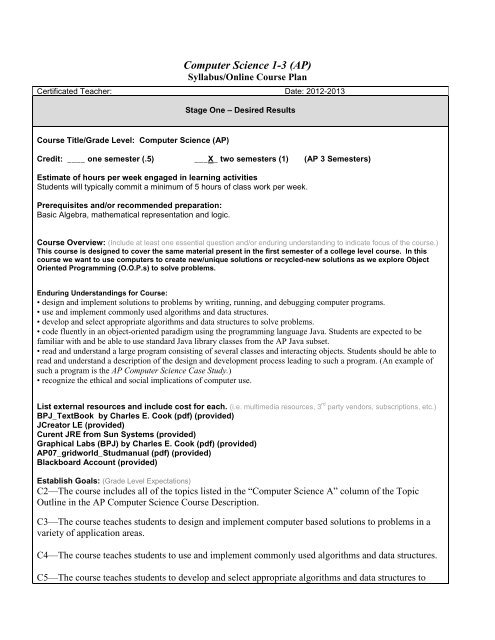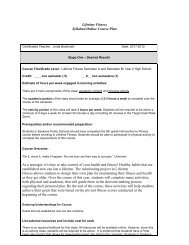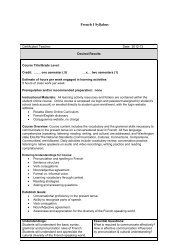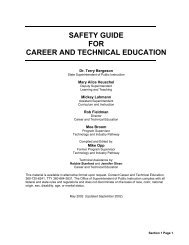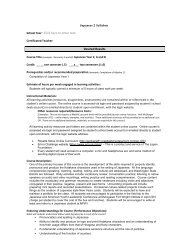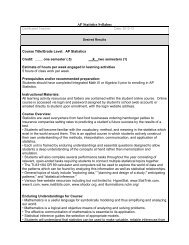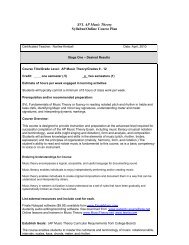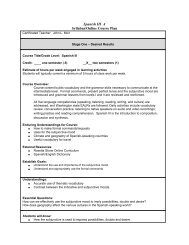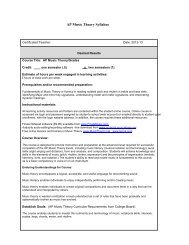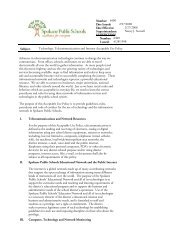Syllabus - Spokane Public Schools
Syllabus - Spokane Public Schools
Syllabus - Spokane Public Schools
You also want an ePaper? Increase the reach of your titles
YUMPU automatically turns print PDFs into web optimized ePapers that Google loves.
Computer Science 1-3 (AP)<br />
<strong>Syllabus</strong>/Online Course Plan<br />
Certificated Teacher: Date: 2012-2013<br />
Stage One – Desired Results<br />
Course Title/Grade Level: Computer Science (AP)<br />
Credit: ____ one semester (.5) ___X_ two semesters (1) (AP 3 Semesters)<br />
Estimate of hours per week engaged in learning activities<br />
Students will typically commit a minimum of 5 hours of class work per week.<br />
Prerequisites and/or recommended preparation:<br />
Basic Algebra, mathematical representation and logic.<br />
Course Overview: (Include at least one essential question and/or enduring understanding to indicate focus of the course.)<br />
This course is designed to cover the same material present in the first semester of a college level course. In this<br />
course we want to use computers to create new/unique solutions or recycled-new solutions as we explore Object<br />
Oriented Programming (O.O.P.s) to solve problems.<br />
Enduring Understandings for Course:<br />
• design and implement solutions to problems by writing, running, and debugging computer programs.<br />
• use and implement commonly used algorithms and data structures.<br />
• develop and select appropriate algorithms and data structures to solve problems.<br />
• code fluently in an object-oriented paradigm using the programming language Java. Students are expected to be<br />
familiar with and be able to use standard Java library classes from the AP Java subset.<br />
• read and understand a large program consisting of several classes and interacting objects. Students should be able to<br />
read and understand a description of the design and development process leading to such a program. (An example of<br />
such a program is the AP Computer Science Case Study.)<br />
• recognize the ethical and social implications of computer use.<br />
List external resources and include cost for each. (i.e. multimedia resources, 3 rd party vendors, subscriptions, etc.)<br />
BPJ_TextBook by Charles E. Cook (pdf) (provided)<br />
JCreator LE (provided)<br />
Curent JRE from Sun Systems (provided)<br />
Graphical Labs (BPJ) by Charles E. Cook (pdf) (provided)<br />
AP07_gridworld_Studmanual (pdf) (provided)<br />
Blackboard Account (provided)<br />
Establish Goals: (Grade Level Expectations)<br />
C2—The course includes all of the topics listed in the “Computer Science A” column of the Topic<br />
Outline in the AP Computer Science Course Description.<br />
C3—The course teaches students to design and implement computer based solutions to problems in a<br />
variety of application areas.<br />
C4—The course teaches students to use and implement commonly used algorithms and data structures.<br />
C5—The course teaches students to develop and select appropriate algorithms and data structures to
solve problems.<br />
C6—The course teaches students to code fluently in an object-oriented paradigm using the<br />
programming language Java. The course teaches students to use standard Java library classes from the<br />
AP Java subset delineated in appendices A and B of the AP Computer Science Course Description.<br />
(Note: Students who study a language other than Java in AP Computer Science must also be taught to<br />
use Java, as specified in the AP Java subset.)<br />
C7—The course teaches students to read and understand a large program consisting of several classes<br />
and interacting objects, and enables students to read and understand the current AP Computer Science<br />
Case Study posted on AP Central.<br />
C8—The course teaches students to identify the major hardware and software components of a<br />
computer system, their relationship to one another, and the roles of these components within the system.<br />
C9—The course teaches students to recognize the ethical and social<br />
Implications of computer use.<br />
Understandings:<br />
What will students understand (about what big ideas) as a result<br />
of the unit? “Students will understand . . . ”<br />
Semester 1<br />
Unit 1: Basic Java—Students will be introduced to<br />
the various primitive data types and distinguishes<br />
when to use each.<br />
Unit 2: Going with the flow—Students will develop<br />
statements and loops to code more efficiently or<br />
adapt to circumstance.<br />
Unit 3: Introducing “Things”—Students will use<br />
classes, objects, strings and arrays to develop<br />
programs.<br />
Unit 4: What goes in…—Processing (formatting)<br />
inputs from various sources.<br />
Semester 2<br />
Unit 5: Bool Loop— Using GridWorld to review<br />
Booleans, switches, and loops.<br />
Unit 6: Creating an Array of Objects —Using<br />
constructors, scanners, and File IO-stream to make<br />
an array of objects.<br />
Unit 7: A Review of 2-D Arrays, Inheritance,<br />
Exceptions and Recursion.<br />
Unit 8: Sorting an Array of Objects —A review of<br />
object comparisons to sort, make sets, or write to a<br />
file (introduction of data structures).<br />
Essential Questions:<br />
What arguable, recurring, and thought provoking questions will guide<br />
inquiry and point toward the big ideas of the unit?<br />
How can we store data? What can we do with it after it is<br />
stored?<br />
How can we write programs that dynamically determine what<br />
to do next? How can we accomplish repetitive tasks easily?<br />
How can I make/use Objects to solve problems? How can an<br />
array help me to manage large volumes of data? Can an abstract<br />
definition make my code more efficient?<br />
What is a data structure? How can I manipulate inputs so that it<br />
may be processed in any way I see fit?<br />
How can we use Booleans, with loops, to solve problems? Can<br />
we combine Booleans and loops to make compact solutions to<br />
complicated or arduous tasks?<br />
Can we define (overload) a constructor to aid in array<br />
implementation? How might an external file be used to initiate<br />
or save a program?<br />
How can inheritance help objects work together? What is<br />
recursion? How might exceptions be used in your program?<br />
What methods exist for sorting an array, list, or an arraylist?<br />
How can you decide which sort method is better?
Semester 3 (AP)<br />
Unit 9: A Review of Wrappers, Arrays, and<br />
ArrayLists.<br />
Unit 10: Data Structures: Linked Lists, Queues,<br />
Heaps, and tables.<br />
Unit 11: Case Study: A prescribed unit from the<br />
College board.<br />
Unit 12: self directed project. The student will plan,<br />
implement a project of their own design (or one may<br />
be assigned).<br />
When might you use the primitive’s wrapper? Can you build,<br />
sort, and make sets of objects?<br />
What is a linked list? When is a queue helpful? Can you use a<br />
heap or table to solve problems?<br />
Can you manipulate (overload/extend objects)? Given a<br />
framework, can you recycle/repurpose the code to suit your<br />
needs?<br />
Can a student make a timeline for themselves? How accurate is<br />
that timeline? Can a student walk themselves through the steps<br />
necessary to design, code, and debug their own code? Can they<br />
control the quality of their own work with less management?<br />
What is the key knowledge and skill needed to develop the desired understandings?<br />
What knowledge and skill relates to the content standards on which the unit is focused?<br />
Students will know:<br />
How to use the java language to develop algorithms that will solve problems.<br />
Students will be able to:<br />
• design and implement solutions to problems by writing, running, and debugging computer programs.<br />
• use and implement commonly used algorithms and data structures.<br />
• develop and select appropriate algorithms and data structures to solve problems.<br />
• code fluently in an object-oriented paradigm using the programming language Java. Students are expected to be<br />
familiar with and be able to use standard Java library classes from the AP Java subset.<br />
• read and understand a large program consisting of several classes and interacting objects. Students should be able to<br />
read and understand a description of the design and development process leading to such a program. (An example of<br />
such a program is the AP Computer Science Case Study.)<br />
• recognize the ethical and social implications of computer use.<br />
<strong>Syllabus</strong>/Online Course Plan<br />
Stage Two – Evidence of Assessment<br />
What evidence will be collected to determine whether or not the understandings have been developed, the knowledge and skill attained, and<br />
the state standards met? [Anchor the work in performance tasks that involve application, supplemented as needed by prompted work,<br />
quizzes, observations, etc.]<br />
Performance Tasks:<br />
Students will read and practice small pieces of a larger target. The students will then take quizzes and complete<br />
projects that may involve several of these pieces. Students will also take Unit Tests which span several quizzes.<br />
Throughout this process students will blog about their debugging process and communicate solutions to their<br />
peers.<br />
Other Evidence (self-assessments, observations, work samples, quizzes, tests and so on):<br />
• Work on a portfolio<br />
• Quizzes through blackboard<br />
• Blogging<br />
• Project submission
Stage Three – Learning Plan<br />
Learning Activities:<br />
What sequence of learning activities and teaching will enable students to perform well at the understandings in<br />
Stage 2 and thus display evidence of the desired results in stage one? Possibly use the WHERE acronym to<br />
design activities (see below).<br />
Each Unit follows the same sequence.<br />
Read a section and practice in JCreator LE.<br />
Blog about bugs, errors and other questions.<br />
Complete a review quiz.<br />
Complete a project.<br />
Test.<br />
Indicate from the table below all applicable learning strategies that may be used in the course.<br />
Direct Instruction<br />
_x___Structured<br />
Overview<br />
_x___Mini<br />
presentation<br />
____Drill & Practice<br />
_x___Demonstrations<br />
____Other (List)<br />
Indirect<br />
Instruction<br />
_x___Problem-based<br />
_x__Case Studies<br />
_x___Inquiry<br />
_x___Reflective<br />
Practice<br />
_x___Project<br />
____Paper<br />
____Concept<br />
Mapping<br />
____Other (List)<br />
Experiential<br />
Learning<br />
____ Virt. Field<br />
Trip<br />
____Experiments<br />
_x___Simulations<br />
_x___Games<br />
____Field<br />
Observ.<br />
___Role-playing<br />
____Model Bldg.<br />
_x___Surveys<br />
____Other (List)<br />
Independent Study<br />
____Essays<br />
_x__Self-paced<br />
computer<br />
_x___Journals<br />
____Learning Logs<br />
____Reports<br />
____Directed Study<br />
_x___Research<br />
Projects<br />
____Other (List)<br />
Interactive<br />
Instruction<br />
_x___Discussion<br />
____Debates<br />
___Role Playing<br />
____Panels<br />
____Peer Partner<br />
Learning _x___Project<br />
team<br />
____Laboratory Groups<br />
_x___Think, Pair,<br />
Share ____Cooperative<br />
Learning<br />
____Tutorial Groups<br />
____Interviewing<br />
____Conferencing<br />
____Other (List)<br />
Scope and Sequence:<br />
Semester One<br />
Week 1<br />
Read/Notes/Quiz Lesson 1<br />
Read/Notes/Exercise/Quiz Lesson 2<br />
Week 2<br />
Read/Notes/Exercise/Quiz Lesson 3<br />
Read/Notes/Exercise/Quiz Lesson 4<br />
Week 3<br />
Read/Notes/Exercise/Quiz Lesson 5<br />
Project 4-1 “Cheating on your Algebra Assignment”<br />
Project 5-1 “Mixed Results”
Week 4<br />
<br />
Read/Notes/Exercise/Quiz Lesson 6<br />
Read/Notes/Circle Project/Quiz Lesson 7<br />
Week 5<br />
Read/Notes/Exercise/Quiz Lesson 8<br />
Read/Notes/Exercise/Quiz Lesson 9<br />
Week 6<br />
Read/Notes/Exercise/Quiz Lesson 10<br />
Project 10-1 “Weight on Other Planets”<br />
Test #1 Lessons 1-10. STUDY YOUR NOTES.<br />
Week 7<br />
Read/Notes/Exercise/Quiz Lesson 11<br />
Bottles of Root Beer song…301<br />
Read/Notes/Exercise/Quiz Lesson 12<br />
Week 8<br />
Read/Notes/Exercise/Quiz Lesson 13<br />
Read/Notes/Exercise/Quiz Lesson 14<br />
Week 9<br />
END QUARTER<br />
Read/Notes/Exercise/Quiz Lesson 15<br />
Loopy WS [nested loops]<br />
Week 10<br />
Old McDonald Song Project [class animal]<br />
Project “Overdrawn at Bank” 15-1<br />
Read/Notes/Exercise/Quiz Lesson 16<br />
Week 11<br />
Read/Notes/Exercise/Quiz Lesson 17<br />
Read/Notes/Exercise/Quiz Lesson 18<br />
Week 12<br />
Encryption Project…<br />
Read/Notes/Exercise/Quiz Lesson 19<br />
Read/Notes/Exercise/Quiz Lesson 20<br />
Week 13<br />
Encryption Project time (See course materials folder)<br />
Test #2 Lessons 11-20 STUDY YOUR NOTES.<br />
Week 14<br />
<br />
Read/Notes /Quiz Lesson 24<br />
Read/Notes/Exercise/Quiz Lesson 25<br />
Week 15<br />
Read/Notes/Exercise/Quiz Lesson 26<br />
Read/Notes/Exercise/Quiz Lesson 27<br />
Week 16<br />
Read/Notes/Exercise/Quiz Lesson 30<br />
Test #3 Lessons 24-30.<br />
Week 17<br />
Project 25-2 Student Averages
Project 30-3 Monte Carlo Technique<br />
Week 18<br />
END QUARTER<br />
Final Game Project (see course materials)<br />
Semester Two<br />
Week 1<br />
Install Bug Jar<br />
Bug Lab 1/journal entry and Bug Lab 2/journal entry<br />
Week 2<br />
Bug Lab 3/journal entry<br />
Bug Lab 4/journal entry<br />
Week 3<br />
Bug Lab 5/journal entry<br />
Bug Lab 6/journal entry<br />
Week 4<br />
Bug Lab 7/journal entry<br />
Bug Lab 8/journal entry<br />
Week 5<br />
<br />
Bug Lab 9/journal entry<br />
Bug Lab 10/journal entry<br />
Week 6<br />
Bug Lab 11/journal entry<br />
Bug Lab 12/journal entry<br />
Bug Lab 13/journal entry<br />
Week 7<br />
Bug Lab 14/journal entry<br />
Bug Lab 15/journal entry<br />
Week 8<br />
Make a bug that has components of each bug lab.<br />
Bug Lab mixed bug/journal entry<br />
Week 9<br />
END QUARTER<br />
Bug Lab 16/journal entry<br />
Bug Lab 17/journal entry<br />
Week 10<br />
Read/Notes/Exercise/Quiz Lesson 33<br />
Bug Lab 18/journal entry<br />
Read/Notes/Exercise/Quiz Lesson 35<br />
Bug Lab 19/journal entry<br />
Week 11<br />
Read/Notes/Exercise/Quiz Lesson 36<br />
Bug Lab 20/journal entry<br />
Bug Lab 21/journal entry<br />
Week 12<br />
Read/Notes/Exercise/Quiz Lesson 37<br />
Read/Notes/Exercise/Quiz Lesson 38<br />
Bug Lab 22/journal entry
Week 13<br />
Read/Notes/Exercise/Quiz Lesson 39<br />
Read/Notes/Exercise/Quiz Lesson 40<br />
Bug Lab 23/journal entry<br />
Week 14<br />
<br />
Unit 4 Test (L:33,35-40) ***One Shot at it***<br />
Read/Notes/Exercise/Quiz Lesson 41<br />
Week 15<br />
Read/Notes/Exercise/Quiz Lesson 42<br />
Read/Notes/Exercise/Quiz Lesson 43<br />
Week 16<br />
Read/Notes/Exercise/Quiz Lesson 44<br />
Bug Lab 24/journal entry<br />
Bug Lab 25/journal entry<br />
Week 17<br />
Read/Notes/Exercise/Quiz Lesson 45<br />
Read/Notes/Exercise/Quiz Lesson 46<br />
Week 18<br />
END QUARTER<br />
Mix Bug, put at least 10 different bug labs together.<br />
Unit 5 Test (L:41-47) ***One Shot at it***<br />
Semester 3 (AP)<br />
Week 1<br />
Retro Bug Lab 23<br />
Read/Notes/Exercise/Quiz Lesson 21<br />
Week 2<br />
Read/Notes/Exercise/ CTB’s /Quiz Lesson 22<br />
Read/Notes/Exercise/ CTB’s /Quiz/Project Milt.Sensor Lesson 23<br />
Week 3<br />
Read/Notes/Exercise/Quiz Lesson 31<br />
Read/Notes/Exercise/Quiz Lesson 32<br />
Bug Lab 27/journal entry<br />
Read/Notes/Exercise/ CTB’s /Quiz/Project PassGravy Lesson 34<br />
Week 4<br />
Read/Notes/Exercise/Quiz Lesson 42<br />
Read/Notes/Exercise/Quiz Lesson 43<br />
Retro Bug Lab 24<br />
Lesson 43 Project “Big Bucks at the Bank”<br />
Week 5<br />
<br />
Read/Notes/Exercise/ CTB’s /Quiz Lesson 44<br />
Retro Bug Lab 25<br />
Read/Notes/Exercise/Quiz Lesson 45<br />
Week 6<br />
Bug Lab 26/journal entry<br />
Read/Notes/Exercise/Quiz Lesson 46<br />
Project (46) HashSet/Intersection<br />
Week 7
Bug Lab 29/ journal entry<br />
Read/Notes/Exercise A&B/Quiz Lesson 47<br />
Bug Lab 30/ journal entry<br />
Week 8<br />
Read/Notes//Quiz Lesson 48<br />
Project (48) Optimized Code for Divisors of a Number<br />
Week 9<br />
END QUARTER<br />
Read/Notes/ CTB’s /Quiz Lesson 49<br />
Read/Notes/ CTB’s /Quiz/Lesson 50<br />
Week 10<br />
Project (50) StackLL Class<br />
Project (50) Stack Calc<br />
Week 11<br />
Read/Notes/Exercise/Quiz/ProjectReverseOrder Leson 51<br />
Read/Notes/Quiz/Project BSTfindMethod Lesson52<br />
Week 12<br />
Read/Notes/ Exercise/ CTB’s /Quiz/Project Who’sNext Lesson53<br />
Read/Notes/ Exercise/Quiz/Project PrintingHeap/AHeapOfTrouble Lesson 55<br />
Week 13<br />
Read/Notes/ Exercise/Quiz/Project Who has PrioLess56<br />
Week 14<br />
<br />
Read/Notes/ CTB’s /Quiz Lesson 57<br />
Project(56)SmilefortheCamera<br />
Week 15-17<br />
Case study<br />
Week 18<br />
END QUARTER<br />
Make a game that uses, random numbers, and four Sem. 3 ideas.<br />
Adapted from Understanding by Design Template available online and the Understanding by Design: Professional Development Workbook.<br />
References:<br />
Wiggins, G., & McTighe, J. (n.d.). Understanding by Design Exchange. Retrieved November 2, 2004 from http://www.ubdexchange.org/<br />
Wiggins, G., & McTighe, J. (2004). Understanding by design: Professional development workbook. Alexandria, VA: Association for Supervision and<br />
Curriculum Development.)


